Growing your peppers can be a very gratifying experience. It is exciting to harvest peppers that can be used as ingredients in some of your favorite cuisines and dishes. For instance, mild varieties, such as bell peppers, are essential for various salads and make for a nutritious snack. However, even though pepper plants are relatively simple to grow, there is still the possibility that you might run into some difficulties. In this article, find out what is eating my pepper plants.

Aphids and spider mites are the most frequent pests of peppers, and you’ll want to keep them FAR away!
For instance, many animals and insects can eat pepper plants and bore holes in them. In most cases, they are plant lice, sometimes known as aphids, and worms, which feed on the sap and burrow into the fruit. Pepper plants are consumed by large animals as well, though most mammals would rather not. However, some omnivores may acquire a taste for hot and sweet pepper plants over time.
But how do you tell which animal is chewing chunks out of your pepper fruits or which insect is eating holes in the leaves of your pepper plant? Well, you can identify the infestation based on the harm done to your pepper plants. Read on to discover more.
Common Pepper Plant Bugs
As I’ve already mentioned, several creatures, critters, and insects love munching on pepper plants. Therefore, you will need to regularly inspect your plants to search for pests such as worms and insects to prevent the spread of these pests. You must also keep the space around your pepper plants in the garden clean and clear of any dead leaves or debris.
Insects love to hide and breed in plant material that has died or is rotting, and these conditions provide the perfect environment for them. Nevertheless, the following are some insects and other creatures that enjoy feeding on pepper plants:
RELATED: What Is Eating My Mint Leaves? A Comprehensive Guide To Mint Pest Control!
Aphids
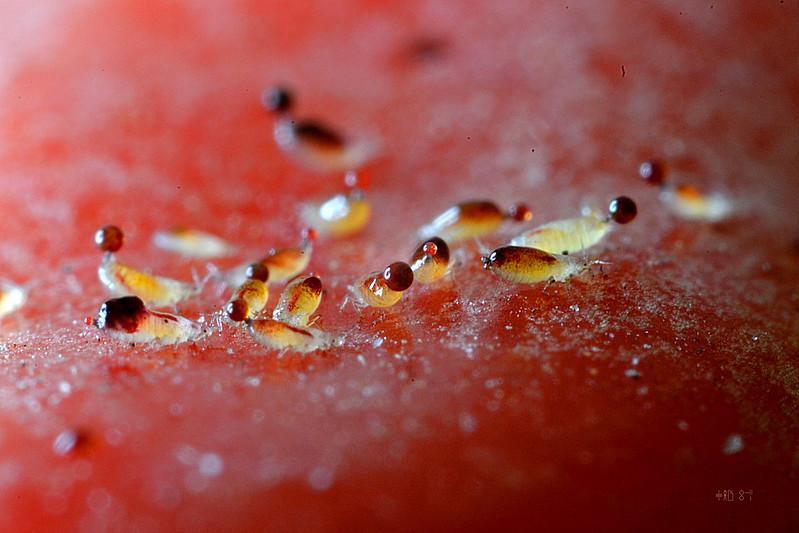
Aphids typically attack the flowers, roots, leaves, stems, fruits, and shoots of young pepper plants.
Aphids are itty-bitty tiny bugs that can be brown, black, green, or red. They range in size from around 1 to 2 millimeters and may or may not have wings.
Aphids are frequent garden pests that will devour the plants in your yard, and pepper plants seem especially appealing to them. Unfortunately, aphids are notoriously tricky to identify with the naked eye, which makes their presence somewhat of a pain in the arse.
Aphids will congregate beneath the pepper plant’s leaves and excrete honeydew, both of which will attract other pests. In addition, aphids can cause the development of spots, as well as the distortion and wilting of the pepper leaves.
Any plant can withstand a few aphids, but an infestation of these pests can be disastrous. In addition, the vast majority of aphids are born pregnant, which allows them to reproduce and take over quickly. So, you will want to rush if you have any reason to believe that aphids are causing damage to your pepper plants.
Control
Aphids can’t jump, and most of them can’t fly. That is why one of the simplest ways to get rid of aphids is to spray your pepper plants with a strong stream of water using a garden hose.
Another method involves placing a plastic cup containing water, vinegar, and brown sugar near the plant infested with aphids. Adult aphids are drawn to sweet liquids; once attracted, they might drown there.
You can also try introducing beneficial predatory insects to your yard. Aphids are at the bottom of the food chain. Introducing insects such as hoverflies, ladybugs, green lacewings, parasitic wasps, and spiders can help you control their numbers.
Caterpillars
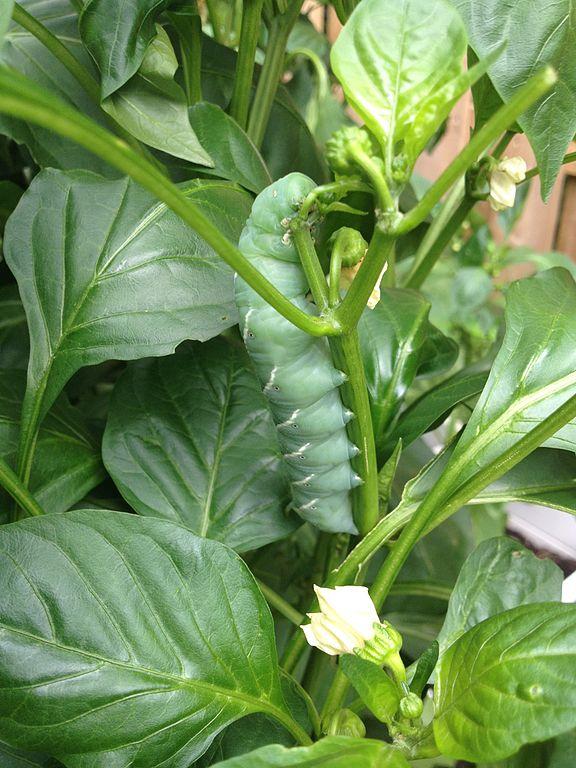
Tobacco Hornworms are large green caterpillars that can devastate your pepper garden.
A caterpillar could be to blame if you have come out to your garden and noticed that a large portion of your pepper plant leaves had been devoured. You also might be able to pinpoint the offender as a caterpillar by looking for the droppings that caterpillars leave on foliage.
Caterpillars of several types can infest your garden. Talk to the employees at the garden center near you to find out which species are most likely to be found in your area. They will chew holes in the leaves most of the time, but they will also consume the stems and the fruit of the plant.
One example is the European corn borer, a white worm with brown hair and a taste for sweet peppers. The borer will lay a clutch of eggs consisting of at least 20eggs. They subsequently develop into moths capable of causing additional damage to the peppers.
Control
Because of their size, caterpillars can be picked up by hand and put in a bucket of soapy water. In a pepper garden, handpicking is typically sufficient to keep caterpillars under control.
Additionally, many birds eat caterpillars, including tobacco hornworms and cabbage loopers. Installing bird houses and feeding pots will draw avifauna to your yard, reducing the population of caterpillars.
Another method is to use a floating row cover to protect pepper plants. It will not solve an existing pest problem. However, it will stop more moths from laying eggs on your pepper plants, preventing future infestation.
RELATED: What Is Eating My Marigolds? The Major Culprits & Some Quick Fixes!
Slugs & Snails
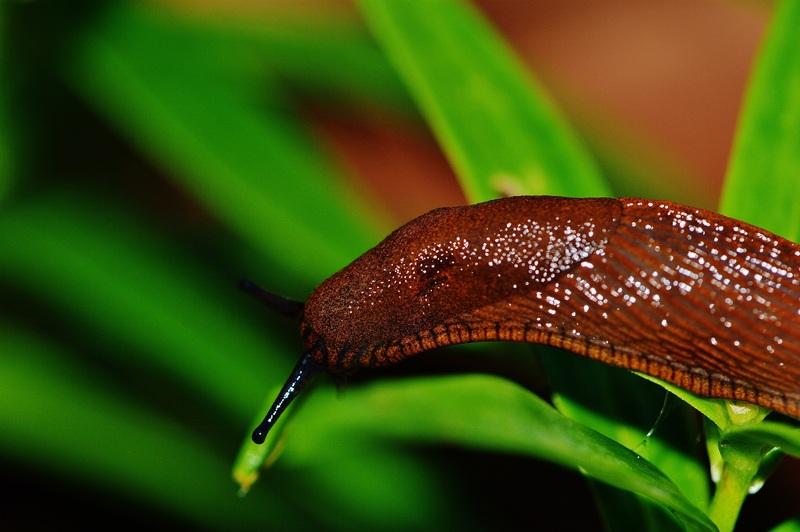
Slugs & snails have rasping mouthparts, leaving smooth holes, unlike other insects that chew on peppers.
Slugs and snails hold the medal of being one of the most devastating pests that can be found in gardens and yards. They are incredibly destructive to young plants. Unfortunately, snails and slugs eat the leaves of a pepper plant if they get a chance. Fortunately, you’ll be able to recognize their presence easily, thanks to the slimy trail they leave behind.
Snails and slugs become a problem when pepper plants are overwatered or irrigated improperly. For instance, If you water your plants later in the day, the soil and possibly even the leaves won’t have enough time to dry up before nightfall. Such conditions provide a perfect environment for snail and slug growth.
Slugs begin their destructive activities in the spring and continue right up to the first frost of the season. They are drawn to the smell of ripening fruit and can be observed feasting on peppers, tomatoes, and a variety of other fruits and vegetables.
Control
Slugs can be controlled without using chemicals by using barriers and traps. For instance, slugs cannot access a garden with copper or diatomaceous earth barriers around the perimeter. T raps made from yeast or beer and placed inside a bowl might draw snails and slugs, causing them to enter and drown.
Alternatively, you can use frogs, toads, shrews, or moles as a biological control to keep snails and slugs in check. In addition, try watering your plants first thing in the morning and allowing the earth to dry up before dusk.
Last but not least, there are chemical management techniques that involve the use of beneficial compounds like iron phosphate. And, if slugs do not eat it, it becomes fertilizer.
RELATED: What Is Eating Holes In My Hostas? Causes & Solutions
Potato Beetles
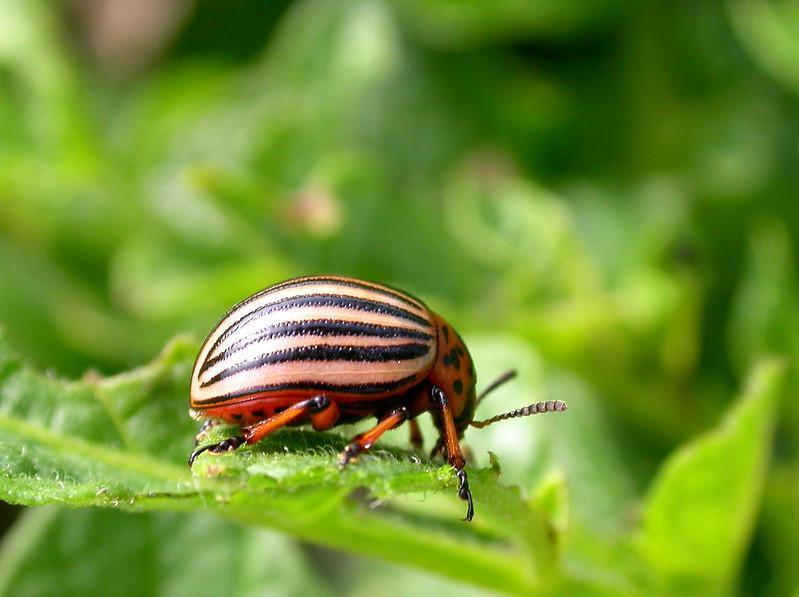
Although they like potato plants, they will readily attack tomato, eggplant, and pepper plants as well.
Potato beetles are destructive insects that attack members of the nightshade family of plants. Both the adults and the larvae of this species feed on the leaves of the plants they infest. Due to the diversity of plants that potato beetles can feed on, eradicating these pests should be a high priority for anyone who grows vegetables. In addition to potatoes, tomatoes, eggplants, and peppers are all on the menu for these bugs’ voracious appetites.
Potato beetles will leave behind holes of varying sizes and in various locations if they congregate in small numbers on a plant. On the other hand, if there is a significant population of these pests, they will begin eating the pepper plants from the top leaves, causing them to become skeletonized as they move downward.
The Colorado potato beetle possesses an unusually high level of resistance to chemical treatments. It quickly develops resistance to toxins, so you’ll either need to kill it by hand or take it out with a flamethrower.
Control
The first step in eradicating the Colorado potato beetle is to conduct an inspection of the damage. Then, only apply insecticides when the damage is extensive, and there is more than one insect on each plant.
These pests have a high degree of adaptability. Therefore, if you use organic insecticides, cycle them frequently. Colorado potato beetles may develop resistance to your pesticide if you only keep using a single one.
You could also place ladybugs in the area, as these insects are excellent predators that feed on beetle eggs, larvae, and adults. In addition, you can apply a spray made of neem oil to prevent the pests from causing further damage to the leaves of your pepper plant.
Pepper Weevils
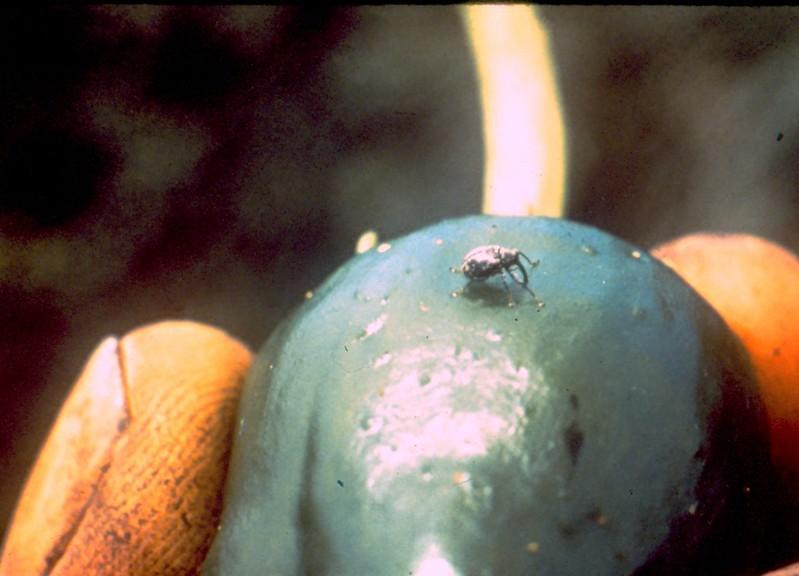
The pepper weevil is one of North America’s most damaging insect pests of peppers.
Pepper weevils are small, hard-bodied insects. They devour the leaves of pepper plants using their lengthy proboscis. Although both larvae and adults consume the pepper plant leaves, the larvae mainly harm the fruit of the hot pepper plant.
Since they can harm pepper plants more than most other pest insects discussed here, you should attempt to eradicate pepper weevils as soon as possible. They pierce the peppers with tiny holes, causing them to wilt and lose color while frequently turning the insides black.
The lengthy sucking mouth of pepper weevils resembles a trunk. When feeding on larger fruits, larvae consume both the fruit’s inner core and walls. In some instances, the infected fruit may not exhibit any visible signs.
In addition to eating the blooms and leaves, they will also drill into the fruit and consume the seeds. If there are numerous dropped fruits at the base of a plant, it might be a sign of ongoing pepper weevil infestation. In addition, fruit that keeps growing can develop deformities.
Control
Once an infestation is identified and fruit-inhabiting pepper weevil larvae are present, pepper weevils are tough to control. A mix of pest exclusion, scouting, sanitation, and insecticide sprays may be needed to reduce yield losses.
Only the adult stages of the pepper weevil are susceptible to insecticides. Insecticides that kill weevils, however, frequently hurt bees as well. The pepper fruit is often where the weevil’s early, vulnerable stages are concealed.
If pepper weevil is an issue, switch to another crop the following season. Culled or dropped fruit should be removed from the field during fruit development and harvest. Also, discard the leftover pepper plant material as soon as possible away from the garden.
Flea Beetles
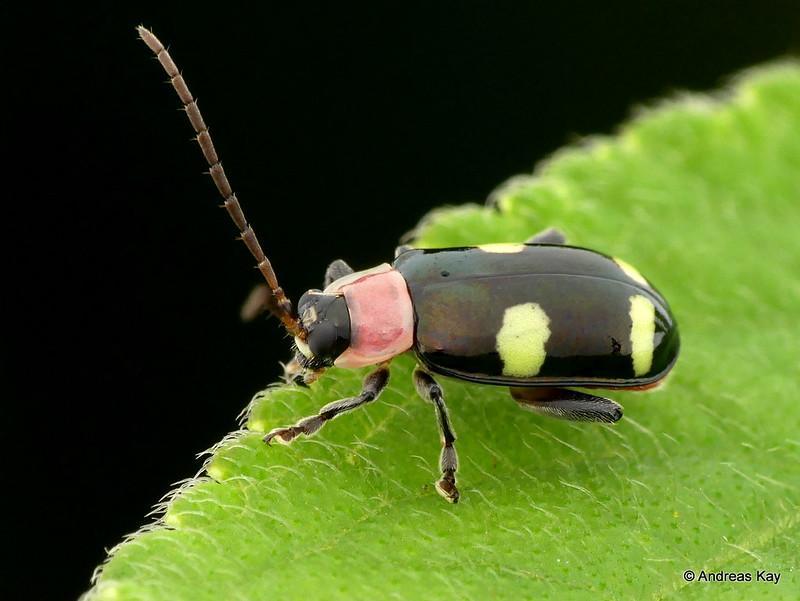
Despite their small size, flea beetles can cause severe damage or kill pepper plants.
Flea beetles are common insect pests on various vegetable crops, including radishes, cabbage, eggplant, peppers, potatoes, and melons. These itty-bitty tiny black insects can hop from one nightshade plant to another. They deposit their eggs in the ground, and as the young emerge, they eat on the plants.
These insects usually favor young plants that have not yet reached maturity or are just at the edge of reaching maturity. Infestations of flea beetles can be identified by the presence of irregular holes in the leaves of pepper plants. These holes are unique to flea beetles. Therefore, if you have recognized them once, you will remember their look the next time.
The presence of shot holes on your leaves is one of the earliest indicators that flea beetles have infested your lawn. Newly chewed holes have a jagged edge, a sign that an insect is currently nibbling away at the leaf. Whereas holes with a smooth, “sealed” edge are more likely to result from an old cut.
Control
Flea beetles are challenging to manage despite their small size. Varied species may have different reactions to your control strategy. Eliminate flea bugs from your garden by removing any remaining pepper plants. Remove any weeds near nightshades and, if necessary, shred them.
Additionally, weed control should be performed in and around planting areas to reduce food availability for flea beetles. To prevent flea beetles from gaining access to the immature pepper plants, cover them with a lightweight floating row cover. When your plants first show signs of flowering, take off the cover.
Spraying plants with an “organic” insecticide such as pyrethrum, neem, or spinosad is recommended for treating severe infestations. There is also the option of using diatomaceous earth to dust the pepper plants.
Spider Mites
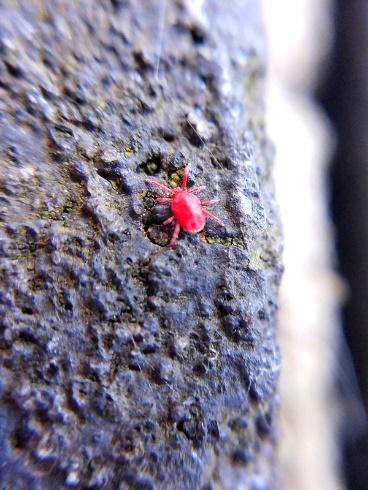
Spider mites feed on plant sap using piercing, sucking mouthparts.
Spider mites are among the most troublesome pests to have in your vegetable garden. They are especially bad for the health of pepper plants. If you detect webbing around the leaves of your pepper plants during the warmest and driest months of summer, you most likely have a spider mite infestation.
These pesky pests come in various colors, sizes, and forms, making it challenging to distinguish them, particularly when they lay eggs. They are typically found on the bottom of leaves, stems, and new growth and have long antennae and short cornicles projecting from behind. They will conceal their presence by laying their eggs on the underside of leaves.
Spider mites don’t just eat the leaves; they also eat the fruit and the flower blooms. Spider mites will have already established a substantial colony by the time you become aware of the damage, so be on the lookout and apply treatment as soon as possible.
Control
It is essential to find spider mites as soon as possible before any damage is observed. To detect spider mites, take a piece of white paper or wood and knock some plant leaf over it.
Spider mites have numerous natural enemies that can be used to inhibit population growth. It is also essential to provide plants with adequate irrigation since drought-stressed plants are at a greater risk of being damaged.
There are two different chemical approaches that can be taken to get rid of spider mites. To begin, you could try using neem oil or another insecticidal oil that kills insects. However, remember that they will kill all insects, not just spider mites.
Conclusion
When growing pepper plants, one of the most typical issues that people run into is discovering holes in the pepper leaves or finding pepper leaves that have been partially eaten. When you realize that something is devouring your pepper plants, it may appear that all of your labor has been for nothing. And once you find holes in your pepper plant leaves, you will realize that plants’ health has also been compromised.
Nobody loves it when the pepper plants have holes in them. In many cases, this is an indication of pests. If you notice holes in your pepper plants, you should look for the culprit bug. You can manually remove large insects or use a spray made of neem oil to repel them.
Avoid using chemical pesticides on your pepper plant and should only turn to use them as a last resort since you could end up doing more harm to your pepper plants than good.
Frequently Asked Questions
What bugs are attracted to pepper?
The pepper weevils and pepper hornworms are arguably the most common insects that attack hot pepper plants. But, despite what their names might imply, they also create problems in other crops besides pepper plants. Other common pests that can harm your peppers are aphids, spider mites, flea beetles, and potato bugs.
How do I get rid of aphids naturally?
If you’re trying to get rid of aphids, a powerful hose spray will knock many of them off the plant, and they won’t be able to return. Aphids can also be controlled by spraying the plant’s leaves with a moderate solution of dish detergent or neem oil.
How do you treat fungus on pepper plants?
Infestations with fungi are a dangerous and destructive ailment that can spread swiftly and wreak chaos on your pepper plants. You can use an organic fungicide like Copper, Serenade, or Actinovate to control fungus on pepper plants. Make sure to spray the growing fruit, stems, and leaves.
What can I spray on my pepper plants?
One of the simplest ways to get rid of bugs on pepper plants is to just spray them with water using a hose. You can spray neem oil or dish soap on your plants if that doesn’t work. Spraying chemical pesticides should only be used as a last resort because they can also kill beneficial insects.
How do you get rid of leaf-eating bugs?
Regularly spraying the leaves to keep them moist is one of the best strategies to fight off leaf-eating bugs. Additionally, you should frequently dust and clean the leaves to stop insects from laying their eggs on them. Several chewing bugs can also be repulsed with homemade concoctions of garlic, onions, and hot pepper.
Should I remove damaged leaves from pepper plants?
Removing any pepper plant leaves that are damaged or turning brown for whatever cause is generally a good idea. Pruning off any damaged leaves from pepper plants will help reduce disease transmission, especially in the case of fungal or soil-borne diseases. Fungal infections spread rapidly from leaf to leaf.
Sources For Further Reading
Peppers Pest Management Guidelines–UC IPM. (2022). Retrieved 30 July 2022, from http://ipm.ucanr.edu/PMG/selectnewpest.peppers.html
IPM Guidelines for Peppers. (2015). Retrieved 30 July 2022, from https://ag.umass.edu/integrated-pest-management/ipm-guidelines/peppers
Pests of Peppers | NC State Extension Publications. Retrieved 30 July 2022, from https://content.ces.ncsu.edu/insect-and-related-pests-of-vegetables/pests-of-pepper
Editor’s Recommendations
Root Maggots: How to Get Rid of Root Eating Insect Pest Naturally?
Identification and Control of Darkling Beetles by Natural and Chemical Ways
An All-In-One Guide to Small Brown Bugs | Fun Facts, Pictures and Identification Guide







